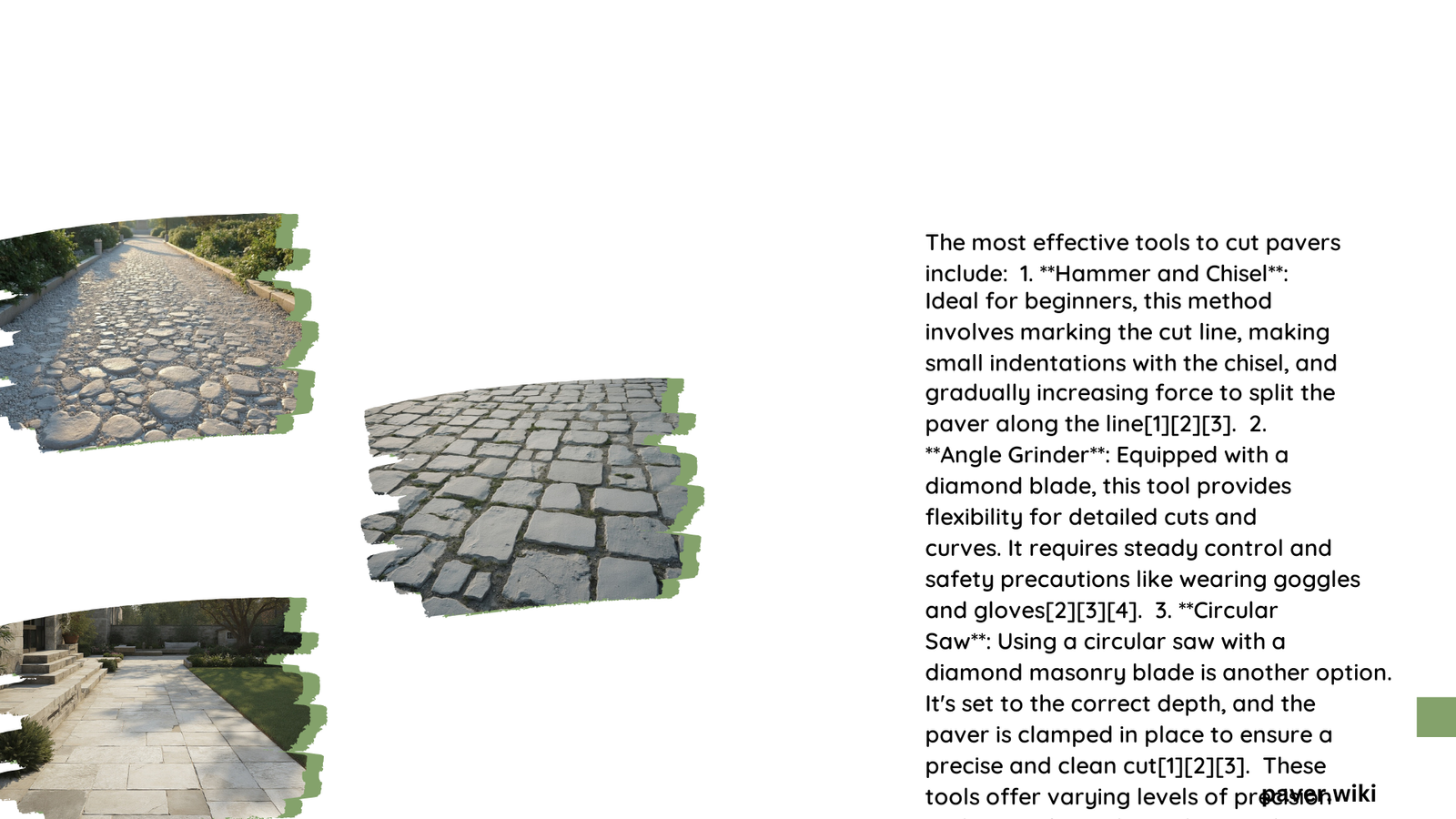Cutting pavers requires specific tools to achieve precise and clean cuts. The most commonly used tools for cutting pavers include paver cutting saws, wet tile saws, masonry chisels, and angle grinders. Each tool has its unique advantages and limitations, suitable for different paver cutting scenarios. This guide explores these tools in detail, helping you choose the right one for your paver cutting needs.
What is the Primary Tool for Cutting Pavers?
The primary tool used for cutting pavers is the paver cutting saw. This specialized saw is designed specifically for cutting through tough materials like concrete pavers. Here’s a detailed look at paver cutting saws:
Features of Paver Cutting Saws
- Blade Types:
- Diamond cut blades
-
Abrasive blades
-
Blade Sizes:
- 7 1/2-inch blades for smaller pavers
-
14-inch blades for larger pavers
-
Cutting Depth:
- 7 1/2-inch blade: 4 to 6 inches
-
14-inch blade: up to 8 inches
-
Power Requirements:
- Electric models: typically 15 amps
-
Some petrol-powered models available
-
Cost Range:
- Basic models: Few hundred dollars
- Advanced models: Over $1,000
Advantages of Paver Cutting Saws
- High precision cutting
- Suitable for various paver sizes and materials
- Efficient for large-scale paver cutting projects
Limitations of Paver Cutting Saws
- Can generate significant dust
- May require additional hand trimming for some cuts
- Higher cost compared to manual tools
What Alternative Tools Can Be Used for Cutting Pavers?

While paver cutting saws are the primary tool, several alternatives can be used depending on the specific requirements of your project.
1. Wet Tile Saw
Wet tile saws are an excellent alternative for cutting pavers, especially when precision and dust suppression are crucial.
Key Features of Wet Tile Saws for Paver Cutting
| Feature | Description |
|---|---|
| Water Usage | 1-2 gallons per minute |
| Blade Type | Diamond blades |
| Cutting Capacity | 12-24 inches in length, up to 4 inches thick |
| Specific Features | Sliding bed, water cooling system, built-in water reservoir |
Advantages of Wet Tile Saws
- Minimal dust generation
- High precision cuts
- Efficient cooling system prevents overheating
Limitations of Wet Tile Saws
- More expensive than other cutting tools
- Requires water supply
- Time-consuming setup and cleanup
2. Masonry Chisel
For smaller projects or situations without access to power tools, masonry chisels offer a traditional method of cutting pavers.
Types of Masonry Chisels for Paver Cutting
- Flat chisels (for initial scoring)
- Brick-set chisels (for final splitting)
Chisel Sizes and Materials
- Sizes: 1-inch to 2-inch wide
- Material: Typically steel, with cold chisels preferred
Technique for Using Masonry Chisels on Pavers
- Mark the paver
- Score with a flat chisel
- Split with a brick-set chisel
Advantages of Masonry Chisels
- Cost-effective
- No power source required
- Suitable for small-scale projects
Limitations of Masonry Chisels
- Time-consuming and physically demanding
- Less precise than power tools
- Potential safety risks
3. Angle Grinder
Angle grinders are versatile tools that can be effectively used for cutting pavers, especially for smaller or intricate cuts.
Specifications of Angle Grinders for Paver Cutting
- Disc Sizes: 4.5-inch and 7-inch
- RPM Ratings: 8,000 to 11,000 RPM
- Disc Types: Diamond discs (preferred) or abrasive discs
Safety Considerations for Using Angle Grinders
- Wear protective eyewear, dust masks, and hearing protection
- Ensure all safety guards are in position
- Keep work area clear of debris
Advantages of Angle Grinders
- Versatile tool with multiple uses
- Suitable for intricate cuts
- Relatively affordable compared to specialized saws
Limitations of Angle Grinders
- May require multiple passes for thick pavers
- Generates significant dust and noise
- Less effective for very thick pavers
How to Choose the Right Tool for Cutting Pavers?
Selecting the appropriate tool for cutting pavers depends on several factors:
- Project Scale:
- Large projects: Paver cutting saw or wet tile saw
-
Small projects: Angle grinder or masonry chisel
-
Paver Material and Thickness:
- Thick or hard pavers: Paver cutting saw
-
Thinner pavers: Wet tile saw or angle grinder
-
Precision Required:
- High precision: Wet tile saw
-
Moderate precision: Paver cutting saw or angle grinder
-
Budget:
- High budget: Paver cutting saw or wet tile saw
-
Limited budget: Angle grinder or masonry chisel
-
Power Availability:
- Power available: Any electric tool
-
No power source: Masonry chisel or petrol-powered saw
-
Dust Concerns:
- Minimal dust: Wet tile saw
- Dust not a major issue: Paver cutting saw or angle grinder
By considering these factors, you can choose the most suitable tool for your specific paver cutting needs, ensuring efficient and effective results.
